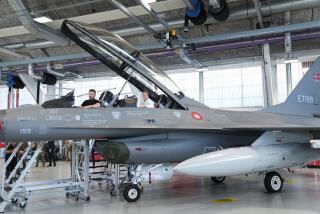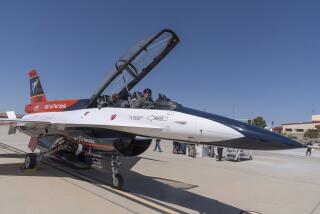Virtual Dogfight
- Share via
Lockheed Martin Corp.’s F-22 Raptor, the next-generation Air Force jet fighter, was unveiled only last month, but already it’s at the center of a pitched battle--this one in the realm of virtual piloting.
In what appears to be an unprecedented move by a military contractor, Lockheed Martin is seeking an exclusive licensing deal with a developer of flight-simulation computer games. The aerospace company is negotiating to sell the rights to the new plane’s name, images, trademarks and even its blueprints to Calabasas-based NovaLogic Inc., and to bar any other game vendors from using them.
The effort has the small but dedicated community of flight-sim aficionados in an uproar. They fear such licensing deals will substantially increase the cost of developing games and limit the number of games based on each piece of military hardware.
Lockheed Martin’s move raises a host of novel legal issues. According to the Air Force, the company doesn’t own the rights to the name, and it’s unclear who controls some of the other rights. And some wonder whether it’s appropriate for a company to license proprietary (but non-classified) information about weapons systems that were developed with taxpayer funds.
“I’m all for protecting a company’s trademarks, but this would be like negotiating with the contractor who built the Golden Gate Bridge for an exclusive license to use the bridge’s name and pictures,” says Dave Loda, a reserve Navy helicopter pilot who provides war-gaming support for the Naval War College in Newport, R.I.
Flight simulations, one of the earliest graphics applications on personal computers in the early ‘80s, have a loyal following among PC game players, with sales of more than $100 million annually. Traditionally, game makers--as well as model airplane companies and just about anyone else who cared--enjoyed free access to public information about U.S. military vehicles.
But with the F-22 Raptor, some lawyers at Lockheed evidently decided otherwise. Earlier this month, NovaLogic received a letter from Lockheed Martin saying that its upcoming game, F-22 Raptor, infringed on Lockheed’s trademark to the aircraft name. The letter warned NovaLogic to remove all references to Lockheed and images of Lockheed aircraft.
On the other side of the country, in Research Triangle Park, N.C., rival game maker Interactive Magic received a similar warning letter relating to its planned flight-sim game, iF-22 Raptor.
John Garcia, NovaLogic’s chief executive, says he was surprised to receive the warning from Lockheed, but he saw it as an opportunity to forge a unique agreement. “We got the same letter that I-Magic got,” Garcia said. “And we figured the effective thing to do was talk to Lockheed Martin. We started by talking with Skunk Works [Lockheed’s famed, top-secret aircraft development lab in Palmdale], but those talks have gravitated to Lockheed’s corporate offices.”
Garcia denied that NovaLogic was trying to secure rights to public information, and said it wasn’t trying to restrict competition. Instead, NovaLogic wanted to get previously unavailable assets from Lockheed, including the cute skunk logo for Skunk Works, the F-22 Raptor logo and, perhaps, blueprints for the plane. Garcia believes that Lockheed’s proprietary information could help make a more realistic game.
I-Magic’s colorful chairman, “Wild Bill” Stealey, had a rather different reaction to the letter: He was furious, especially since it came a mere month before his game’s June release. And he feared that Lockheed’s action might set a costly precedent in the flight-sim industry.
I-Magic posted a portion of Lockheed Martin’s cease-and-desist letter on its Web site and opened a forum to gamers, letting them discuss the possible NovaLogic pact. The forum has been raging for a couple of weeks, with some calling for a boycott of NovaLogic and others suggesting phone calls to Lockheed.
“If NovaLogic makes a deal, then it changes the economics of the industry,” said I-Magic spokeswoman Lynne Beaman. “We don’t want anyone to lock up a piece of military hardware. It makes the cost of making the game more expensive, and the price will go up for consumers.”
Beaman said many at Lockheed--which has traditionally been happy to cooperate with the game company--were as surprised as I-Magic that the aerospace company was trying to license its materials.
Lockheed Martin spokesman Jeff Rhodes said Lockheed had never asked for licensing money in the past but that a meeting is scheduled for the first week of June to look at the matter.
“Our lawyers say that we own certain things,” Rhodes said. “Some of the plane’s technology is owned by us, but I’m not so sure about the pictures and images. The lawyers are hashing that out right now.” Rhodes said giving NovaLogic a blueprint to the plane would probably require the permission of the Air Force.
Lt. Col. Napoleon Byars, chief of Air Force public affairs, said the names F-22 and F-22 Raptor are in the public domain and can’t be trademarked.
Byars said the Lockheed letters mark the first time that someone has tried to trademark a fighter designation. His office had received a request of ownership from Lockheed for the distinctive F-22 logo, he said, but no decision on that has been made.
“In our experience, images of aircraft have been in the public domain,” Byars said. “But I haven’t seen the entire letter from Lockheed, so I can’t judge it. When they say ‘images,’ what exactly do they mean? You can’t really own an image of a public entity, but if Lockheed took a photo or a design came from their computer, that’s a different story.”
Byars also said the first F-22 Raptor still officially belongs to Lockheed, because it hasn’t yet been delivered to the Air Force. (The F-22, in development since the early 1980s, combines stealth, maneuverability and speed and is designed to replace the F-15.)
Meanwhile, many in the flight-sim community fear repercussions from a Lockheed/NovaLogic deal. Digital Image Design of Britain is planning a game based on the F-22 for the fall, but the company hasn’t received warning letters. It called for an amicable agreement, saying NovaLogic, I-Magic and Lockheed should meet in an open forum to resolve the issue.
Flight-sim enthusiasts were a bit less sanguine, with many worried that an exclusive deal would bring monopolies for each military flight-sim game.
“An injunction against I-Magic would greatly retard the development of cutting-edge flight sims,” said Loda, the reserve Naval helicopter pilot.
Lockheed said the usual free information given to model plane makers also will be discussed at the June meeting. That piqued the interest of David Miller, president of Rockford, Ill.-based Testor Corp., which makes a line of Lockheed airplane kits.
Miller, who attended the F-22 roll-out in April, said he had never paid a license fee for military aircraft, though car makers recently started charging such fees.
“It really opens a can of worms,” Miller said. “Car companies used to think of models as a good way to get kids interested in their cars. Now they see it as a profit center. With military equipment, we always assumed it belongs to the public. If anyone should be doing the licensing, it should be the government.”
*
Web sites related to the flight-sim controversy:
Interactive Magic: https://www.imagicgames.com
Lockheed Martin’s F-22 page: https://www.lmasc.lmco.com/f22
NovaLogic: https://www.novalogic.com
Testor: https://www.testors.com
Air Force: https://www.af.mil
*
Mark Glaser writes the Cybertainment column for The Times’ Thursday Calendar section. He can be reached at [email protected]






